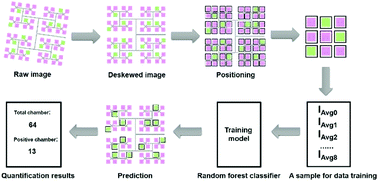A new method using machine learning for automated image analysis applied to chip-based digital assays†
Abstract
Chip-based digital assays such as the digital polymerase chain reaction (digital PCR), digital loop-mediated amplification (digital LAMP), digital enzyme-linked immunosorbent assay (digital ELISA) and digital proximity ligation assay (digital PLA) need high-throughput quantification of the captured fluorescence image data. However, traditional methods that are mainly based on image segmentation using either a fixed threshold or an automated hard threshold failed to extract valid signals over a broad range of image characteristics. In this study, we introduce a new method for automated image analysis to extract signals applied to chip-based digital assays. This approach precisely locates each micro-compartment based on the structure design of the chip, thereby eliminating the interference of non-signal noise in the image. Utilizing the principle that the human eyes can distinguish between the positive micro-compartments and the negative micro-compartments, we take the parameters of each micro-compartment together with its surrounding micro-compartments as the training dataset of the Random Forest classifier to classify the micro-compartments and extract valid signals, thus solving the problem caused by the differences among images. Furthermore, we adopted the iteration methodology that adds the output of a model's prediction to the input of the next model's training dataset, until the output of a model's prediction reaches the accuracy we expected, which improves the work efficiency during data training greatly. We demonstrate the method on the dPCR dataset and it performs well without any manual adjustment of settings. The results show that our proposed method can recognize the positive signals from the fluorescence images with an accuracy of 97.78%. With minor modification, bio-instrument companies or researchers can integrate this method into their digital assay devices’ software conveniently.

- This article is part of the themed collection: Bioanalytical tools for enabling precision medicine


 Please wait while we load your content...
Please wait while we load your content...